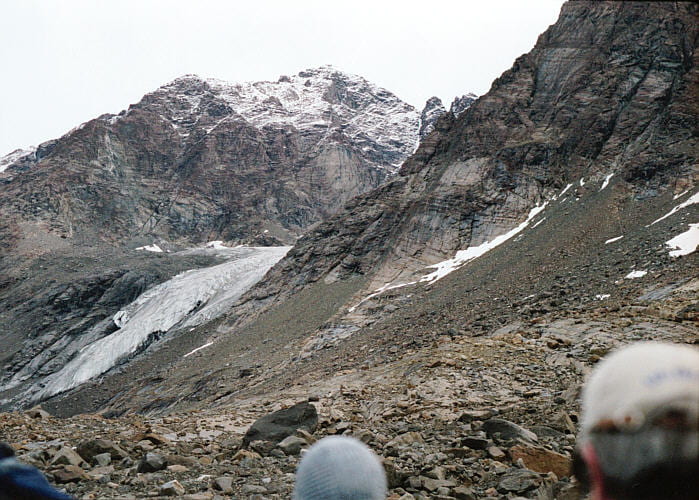This day was unusual, as we visited three different places, with Zodiac transport in between.
West side of Pukugagryggen
View to the northwest toward Wager’s Top from the landing area on the shore of Uttental Sund. Visible below Wager’s Peak are the Triple Group layers, highlighted by snow, and the largest known autolith to the upper right of the glacier. This autolith block is >400 m across. Layers can be seen lapping up onto the left flank of the autolith. On the flanks of Pukugagryggen, the mountain to the right, the Triple Group is visible near the upper right of the photo, and a bit lower down is a large autolith. These rocks, and the rocks of this area are all in the MZ. Click the left or right button to see an annotated version: red lines indicate the Triple Group, red A’s are large autolith blocks, and blue lines and M’s denote the macrorhythmic layered section.
OK, I realize the images above are crummy, and don’t really show what I wish they would. Elements magazine had an issue on layered intrusions in 2017 (December, v. 13, no. 6), with a spectacular picture of (what I think is) this same southern Wager’s Top cliff on its cover. See it here. Wow! The rest of that issue isn’t bad, either.
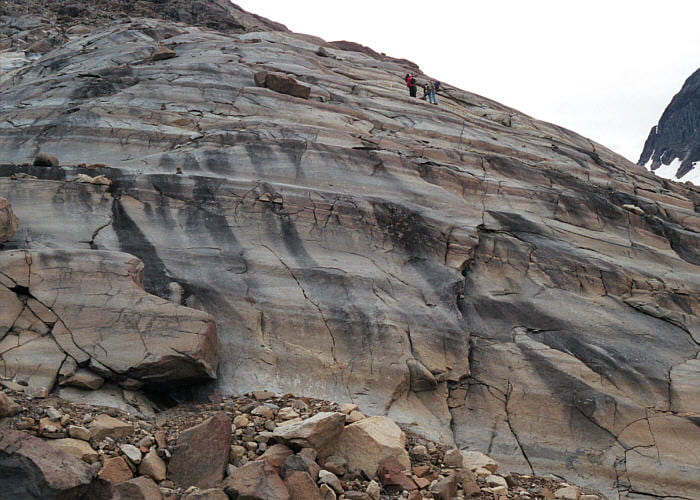
Steep slope exposing a prominent macrorhythmic layered section. Layering is somewhat diffuse, but clear at a distance at a scale of 0.5 to 3 m.
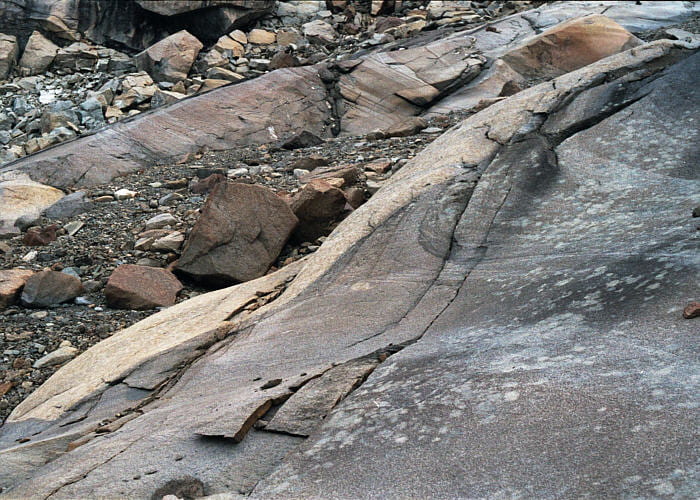
A large gabbroic anorthosite autolith block (light-colored) from its south side, showing beds lapping up on the edge of the block.
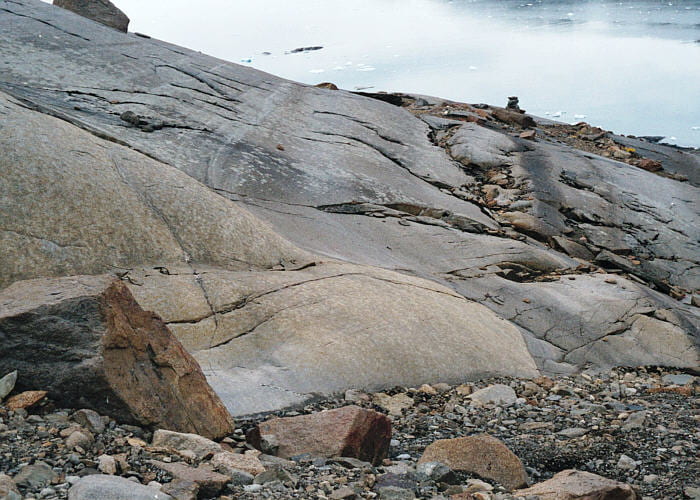
The same block as in the photo above, but from the north side looking south. The beds coming toward the block are straight in the distance, and bend down below a particular level, and curve up above that level. The straight bed may represent the first bed deposited after block impact.

Beautiful graded beds within homogeneous beds in a broad trough just to the southeast of the large block in the two photos above.
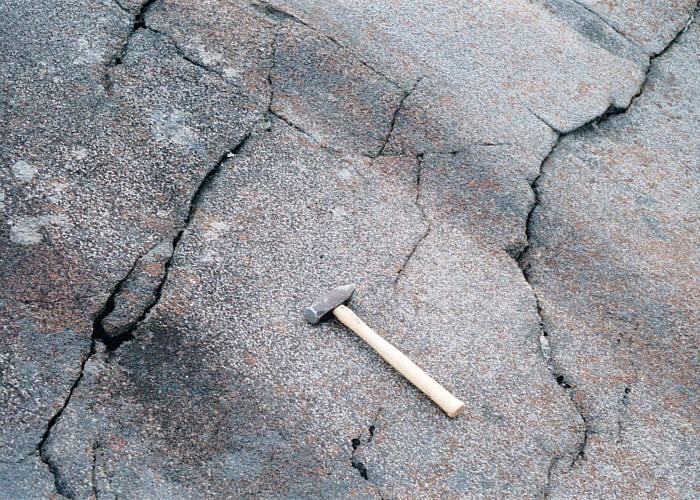
Some of the thinner macrorhythmic layers that are stratigraphically above the block shown in the photos above. Note the diffuse variations in modal composition, and the lack of unidirectional grading.
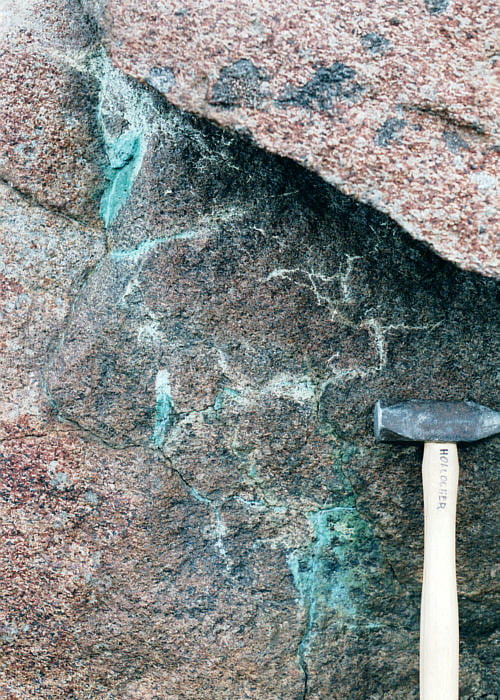
Copper staining from fractures at approximately the level of the Triple Group layer 0, which is a thin leucocratic layer that lies below the Triple Group proper.

View to the southeast toward Ivnarmiut Island (center), with the Homestead area to the left. The toe of Forbindelses Glacier is visible to the lower left.

View to the northwest, up Uttental Sund. Uttental Plateau is off the picture to the right, though a lower plateau of Archean gneiss is visible center to a bit right of center. Kramer Island is on the left.
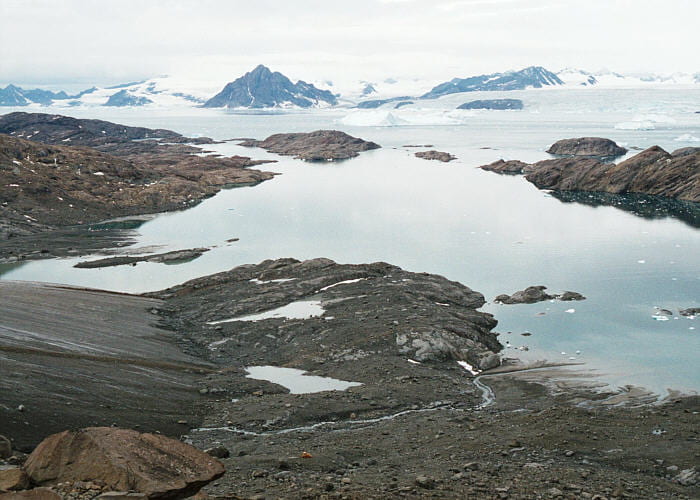
Another view looking south toward Ivnarmiut Island. In the 1930’s the outcrops below center were under glacial ice. The dirty, smooth slope on the left is the toe of Forbindelses Glacier, from which a subglacial stream emerges.

Looking north toward the prominent macrorhythmic layering (center) on the lower west flank of Pukugagryggen. A large, light-colored autolith block lies on top of them, and a thinner one within them, almost exactly in the image center. When we were standing on the Triple Group members, they were rather hard to distinguish. They are easier to see from far away.
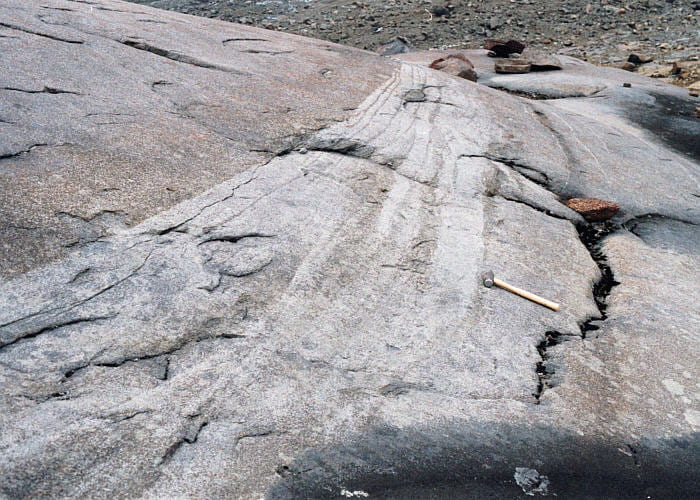
Region of disturbed and unusual layering to the south of the top of a large autolith block, to my back.
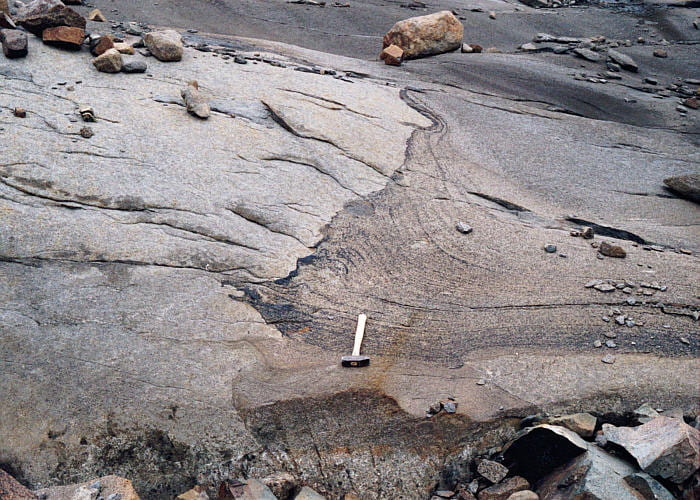
Beds lapping up on the margin of a large anorthositic gabbro autolith block, near the Zodiac landing place.
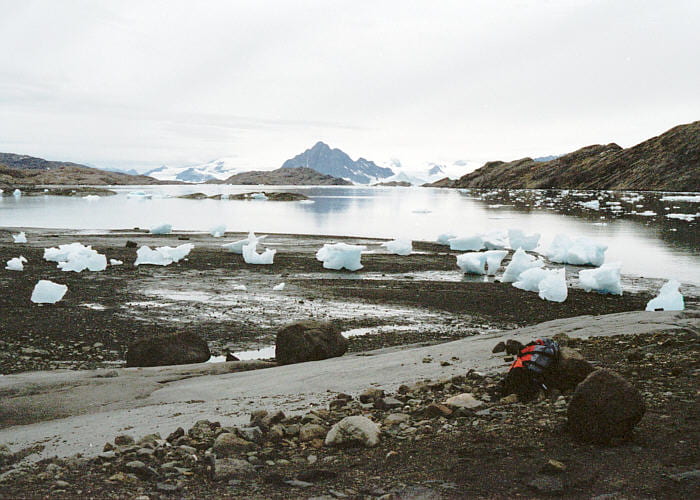
Sea ice chunks stranded by low tide. Uttental Sund behind, Kramer Island to the right, Homestead area to the left.
Southeastern tip of Kraemer Island
We crossed Uttental Sund by Zodiac to the southeastern-most point of Kraemer Island, where the Triple Group is exposed.
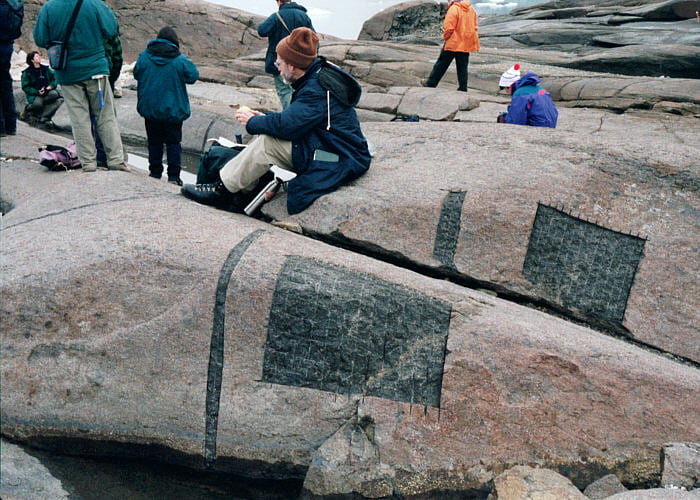
This is the lowest of the Triple Group beds, in the upper part of the MZ. The Triple Group, and a felsic layer not far below it, are the hosts for most of the gold and platinum group elements. Though not very clear here, the Triple Group layers are themselves made of smaller-scale layers. The rectangles are the results of some panel and channel sampling that was done by the Platinova mining company, as part of their exploration effort that also included numerous drill holes. Gold and platinum group elements are not visible in place in the field, though small bits have been found by panning stream deposits below the Triple Group. Notice the dark fresh rock compared to the weathered surface.
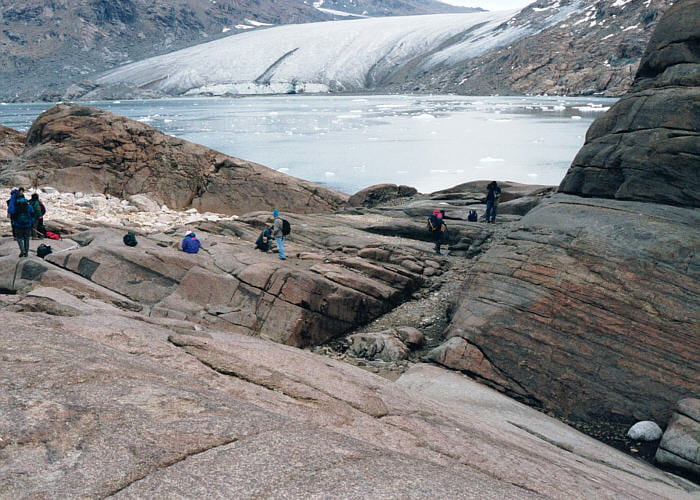
View to the northeast across the lowest member of the Triple Group in the near ground, overlain by interlayered, darker and more mafic rock to the right. In the distance is Uttental Sund and the toe of Forbindelses Glacier.
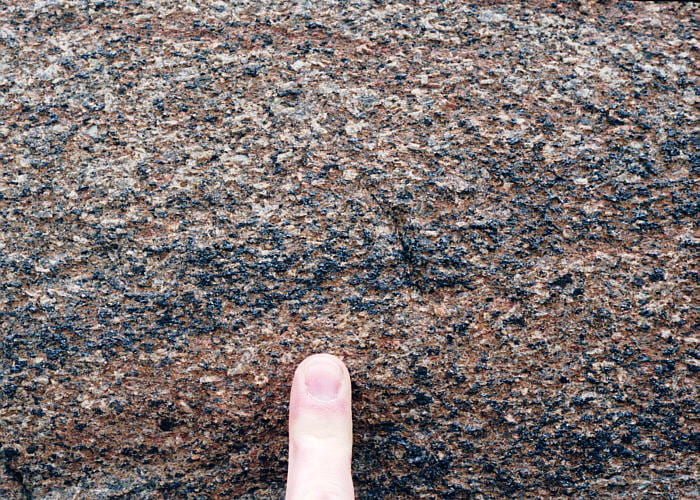
Close-up near the base of the thick, relatively mafic layer overlying the lowest Triple Group member, in the photo immediately above, showing modally graded oxide-rich beds.
Mellemø Island
We traveled again by Zodiac to the northwest end of Mellemø Island, landing on the Archean gneiss and then walking across the intrusion contact and through most of the Marginal Border Group.

This is the Skaergaard intrusion contact against partially melted Archean gneiss, on the western margin of the Skaergaard pluton. The black spots are lichen, but there are numerous brown, angular xenoliths broken from the intrusion margin that are visible in the leucocratic mass.
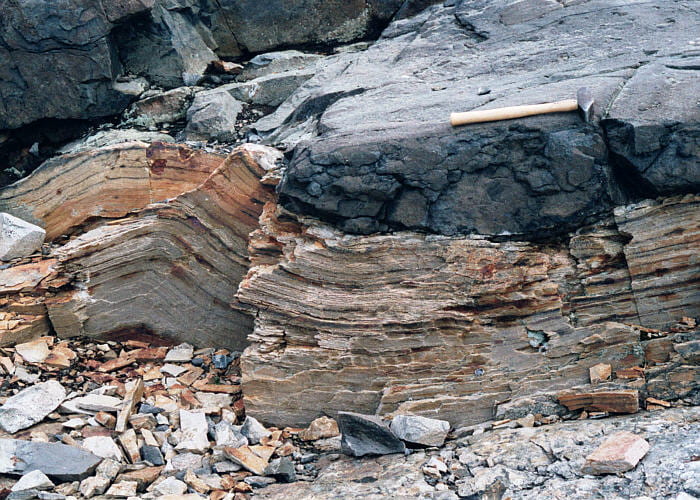
Contact metamorphosed, layered Cretaceous sediments against the Skaergaard gabbro, above. The sediment thickness here is only ~0.8 m, below which, at the bottom center and right of the photo, is Archean gneiss, on which the Cretaceous sediments unconformably rest.

Partially melted Archean gneiss intruding as a dike into Skaergaard gabbro. Liquids from material like this may have been the source of the transgressive granophyre dikes.
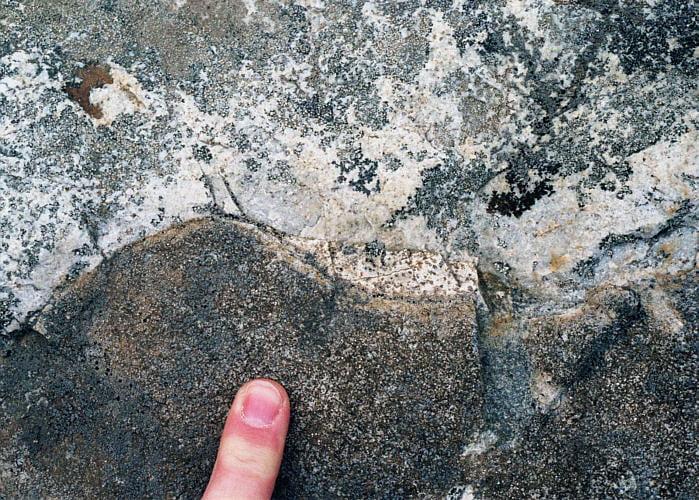
Another view of the intrusion contact showing dark gabbro below, partially melted Archean gneiss above, and a small lens-shaped sliver (center) of spinel-bearing Cretaceous sediments, unconformably overlying the Archean gneisses.

Perpendicular feldspar rock ~10 m in from the gabbro–Archean gneiss contact. These probably grew very close to the rock-magma interface and probably did not protrude far into the magma. Note that they grow here in dendritic forms rather than straight single crystals.
As I recall, perpendicular feldspar rock marks the formal end of the contact zone and the start of the “Tranquil Zone”, which, though free of layers like the Layered Series, has a lot of other kinds of layers and appears to have had a lot of action (i.e., not tranquil).

“Wavy pyroxene rock”, which is gabbro having small, wavy, pegmatitic stringers within it. The pegmatitic zones contain large pyroxenes. Layering here is dips 70 to 80° to the east (left), toward the pluton center.

Close-up of one of the wavy pyroxene stringers, showing the irregular, wavy shape, large pyroxenes and plagioclase, and the matrix olivine gabbro.

Apparent slump folds in the “Tranquil Zone”. Pluton interior is to the left.

Colliform layering, probably in the Marginal Border Series unit LZb*. The pluton interior is to the left, so this colliform layering has the rounded parts convex inward, and the cusps pointing outward. These are growth features, not erosional.

Colliform layering in LZb*, with pegmatites close to the coliform margin. The pluton interior is to the right.

Looking southeastward across the plateau on top of Mellemø Island. Near vertical colliform layering in LZb* extends into the distance. Pluton center is to the left.
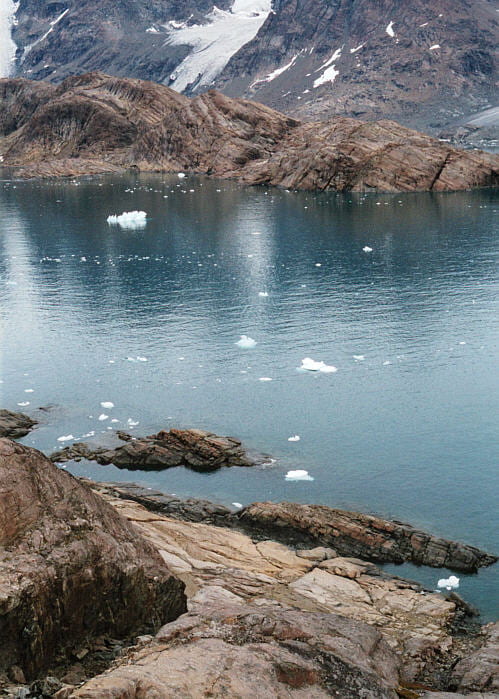
Looking northeast from the east end of Mellemø Island. Rocks in the near-ground, at the image bottom and extending into the water, are of the Marginal Border Series LZc*, with nearly vertical layering. However, the rocks in the middle distance across the water are in the MZ, with their layers lapping up against the MBG. The MZ rocks are part of the southeastern peninsula of Kraemer Island, visited above. The prominent macrorhythmic layering is visible, the same layering photographed on the west flank of Pukugagryggen.
